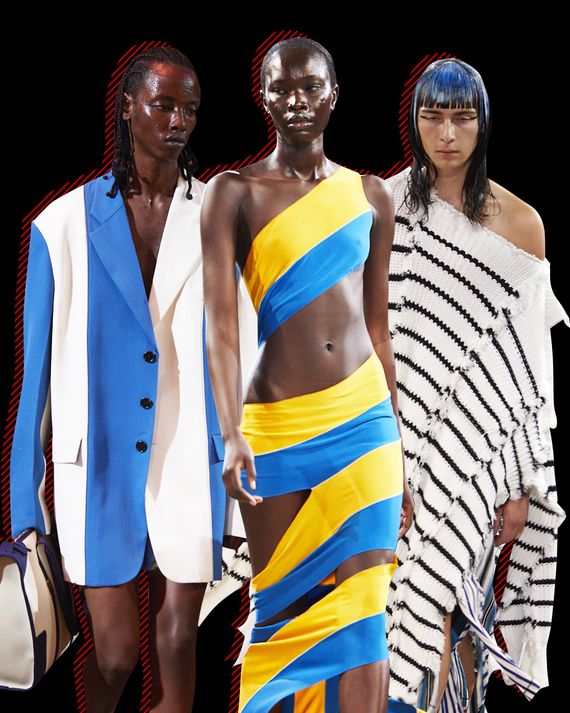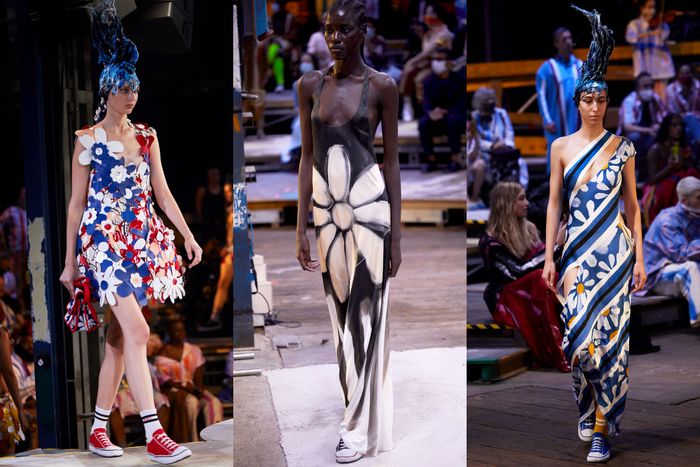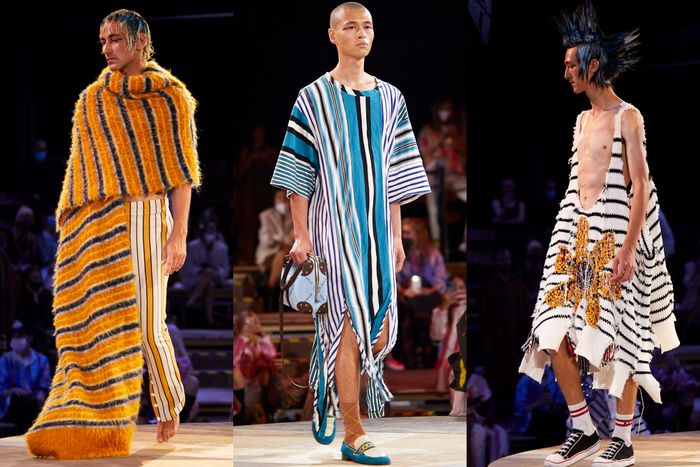
Around 8 p.m. on Saturday night, our driver, Franco Magnani, who called himself Fred, deposited us on a dark Milan street corner and, pointing, said, “It’s down there.” We found the entrance to the Marni show easy enough, since not much else in the seedy, factory area was illuminated and some groupies were waiting in the street by the entrance, though nothing compared to the hordes outside most of the shows.
Only in hindsight would this disharmony — between how things appear on the outside and how they actually are — become meaningful. Earlier in the day, I’d attended Giorgio Armani’s show, held in the theater of his central Milan palazzo. The space has not been used for shows in twenty years, not since Armani’s heyday as the king of soft tailoring. That style, now in sea shades of green and blue, was still on masterful display. Yet, from the throngs of young people on the barricaded sidewalk, one would have thought something momentous was happening. The disconnect was even greater at Ferragamo, where the clothes — weird diaper-style shifts, cotton ponchos, absurdly high-waisted pants — had little relevance. They certainly didn’t warrant the frenzy outside.
Marni was the total opposite experience: everything that happened, everything that was real and emotional, occurred as a spontaneous result of a few hundred people coming together inside a dank building to look at clothes. Since the start of the pandemic, this has been a big question in the elite tier of the industry: what would it be like again to gather? How should one feel? And how might a designer seek a strong emotional response? I doubt that Marni’s creative director, Francesco Risso, knew himself how well things would turn out, despite the considerable planning that went into the show. This included dressing guests in the audience (mostly in hand-painted cotton striped shirts, loose pants, or dresses); assembling a choir and small orchestra, and working with the remarkable musical artists Dev Hynes and Zsela, who sang Hynes’ slow, stirring work, “Guide You Home.”
Indeed, I suspect that only in Risso’s subconscious did he sense that all these elements could come together. It was a huge risk, then.
In lieu of a straight runway, there was a circular wooden platform surrounded by a series of wooden risers for the audience, the material seemingly recycled lumber. The decor wasn’t fancy anyway. Editors and writers laughed and admired each other’s looks, in variously colored stripes, yet it was hard at first to understand why we, too, needed to be outfitted. We were still seated as a group, as an audience.
I don’t remember whether the show started with models or members of the choir walking along the top risers as they sang. Within minutes, the audience was flooded with people. It was the most extraordinary cast. We hear a lot today about diversity and gender fluidity, to the point where these principles can seem almost trite, especially when pushed at a fashion show.
Yet Risso’s diversity looked unforced — as ordinary in its extremes as you see in most big cities. The clothing was also apiece with the attire of the audience, though bolder and more exaggerated. Oversized blazers came in wide rugby stripes, while jersey dresses had spiraling stripes that opened at random places in the seams. There were dresses and tops stuck with clumps of stiff, colorful daisies, and a wonderful, gigantic poncho-style sweater in Breton stripes, with a silver-embroidered daisy cutout in front. The clothes looked cool — weird, comfortable, not so fashion-y. The punk head pieces worn by some of the models were the work of the legendary hair stylist Julien d’Ys. Molded from latex, they were originally painted black, but d’Ys told me later that the oily, creatures-from-a-lagoon look was not the right vibe at all, so they were painted bright blue.
Risso also walked in the show and then took a seat on the lowest riser. If any individual had a galvanizing effect in the show it was Zsela, dressed in a blue and white daisy skirt and bra top, with matching shoes. She has an extraordinary voice, low and deep, and she intones the words slowly.
Little by little, as Zsela gave meaning to “Guide You Home,” as the models in their kooky knits and stripes filled the circle, and the orchestra added a flourish, the spectators and the show melded together. Clothing is not art, but it can produce similar feelings of pleasure and community.
Ever since the New York shows, people have casually wondered if in the age of Instagram and big, corporate-owned fashion brands, designers are obsolete. There were some surprisingly banal collections in Milan, as if brands had cynically — or fearfully? — identified a few signature styles and then hit the repeat button. Marni, however, demonstrated that creative designers are not obsolete. As Risso got up from his seat and joined Zsela and the models on the platform, the audience broke into a sustained applause. Some people stood and some even wept.
Armani’s collection was effective in its own way, in part because the designer, who is now 87, does not deviate from his aesthetic and in part because the palette of sea and shell tones (spiked with hot pink) was so sublime. In the first dozen or so looks, Armani offered as many styles of jackets. Who does that today for their eclectic and worldly clientele? Not many. He reminds me a lot of Saint Laurent in the twilight of his career. The man has done everything, and now he’s speaking in a whisper.
Marco Zanini also had a lovely collection, with some of the nicest quality fabrics and original prints around. That’s no small thing for an independent brand. This season, his clothes had a fresh lightness, with full skirts in a dark blue or brown cotton stripe, a beautifully cut shirt dress in an ivory silk crepe basket print, his comfy, wide-leg trousers, and oversized white shirts in luxurious Sea Island cotton, including one with a dramatically wide tie you can turn into a bow or a stole neckline. Zanini thinks of every detail.
The Milan shows ended with an unexpected coda: a combined show, at Gianni Versace’s mansion, with Kim Jones of Fendi doing his version of Versace’s Medusa prints and chain mail, and Donatella Versace playing with Fendi’s signifiers. The designers, along with Silvia Venturini Fendi, cooked up the one-off collection last February over a meal. The connection between the two labels makes sense in one way: Gianni Versace and Karl Lagerfeld were great friends. Collaborations are also popular. (Remember the Balenciaga-Gucci hookup last spring?) One writer said to me, “But who wins?”
I would say, looking at the images of Shalom Harlow in pale pink “Fendace” lace and Kristen McMenamy in a drop-dead gown with fat gold safety pins, that probably Versace comes out on top, simply because Gianni’s original iconography is so enduring. But in another sense, the question is mute. “Fendace” marks a communal moment, a return, but it’s still just a vanishing moment.
More From Milan Fashion Week
- Under-Eye Bags Are Glowing Up
- Milan Fashion Week Street Style: All the Looks
- At Milan Fashion Week, Prada Seduces









